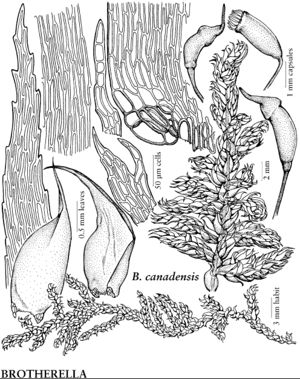Brotherella
Nova Guinea 12: 119. 1914.
| Taxon | Illustrator ⠉ | |
|---|---|---|
 | Brotherella canadensis | Patricia M. Eckel |
Plants small to large, yellow, golden, pale green, or yellowish-brown, glossy. Stems 2–12 cm, complanate-foliate, pinnate to irregularly branched. Leaves erect-spreading to falcate-secund, ovate or ovatelanceolate; margins serrate to serrulate near apex (occasionally entire in B. henonii); apex short to long-acuminate; ecostate; alar cells elongate, inflated, pigmented, walls thin, region distinct in 1 row, middle lamella not apparent, supra-alar cells differentiated; laminal cells linear-rhomboidal, smooth. Sexual condition dioicous, autoicous, or sterile. Seta 0.5–2 cm. Capsule inclined or suberect, cylindric to oblong-cylindric; exothecial cell-walls not collenchymatous; operculum short to long-rostrate.
Distribution
North America, Europe, Asia
Discussion
Species ca. 20 (4 in the flora).
Brotherella is a problematic genus in which species are often polymorphic. Fragmentary material from other genera has been attributed to this genus, thus the systematics remain in flux. In northwestern North America there remain several specimens difficult to place, partly because material is sterile; these may well represent responses to extreme environments. The leaf margins are often recurved basally and plane distally; the acumina are curved; the supra-alar cells are shorter than the alar cells and in 1 or 2 rows; and the capsules are 0.5–2 mm.
Selected References
None.
Key
| 1 | Plants small; stems to 1 mm wide across main leafy shoot; capsules suberect. | Brotherella roellii |
| 1 | Plants medium-sized to large; stems 1.5-2 mm wide across main leafy shoot; capsules inclined or unknown | > 2 |
| 2 | Stems 4-6(-12) cm; leaves erect. | Brotherella henonii |
| 2 | Stems 2-4(-10) cm; leaves falcate-secund | > 3 |
| 3 | Stems not complanate-foliate; plants yellow to golden green; alar cells orange. | Brotherella canadensis |
| 3 | Stems markedly complanate-foliate; plants pale green to yellow-green; alar cells yellowish. | Brotherella recurvans |